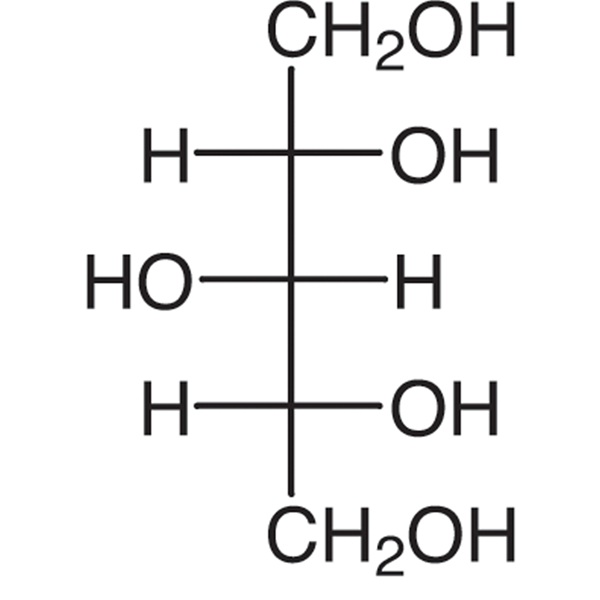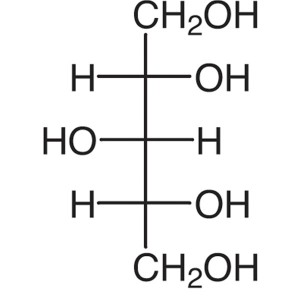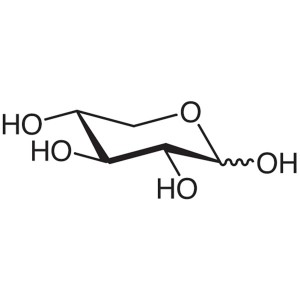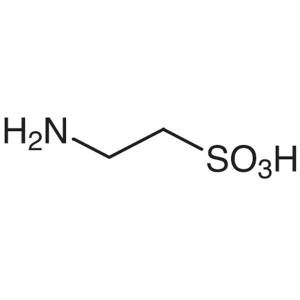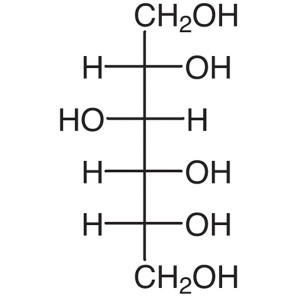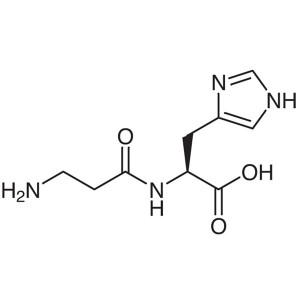Xylitol CAS 87-99-0 Assay 98.5~101.0% Factory High Quality
Shanghai Ruifu Chemical Co., Ltd. is one of the leading suppliers of Xylitol (CAS: 87-99-0) with high quality, production capacity 15000 tons per year. Xylitol is sold to domestic and foreign markets, deeply trusted by our customers. We can provide worldwide delivery, small and bulk quantities available. If you are interested in Xylitol (CAS: 87-99-0), Please contact: alvin@ruifuchem.com
| Chemical Name | Xylitol |
| Synonyms | meso-Xylitol; Xylite; Xylite (Sugar); Xyliton; C-Xylidex; DL-Xylitol; Wood Sugar Alcohol; Xylisorb; xylo-Pentitol; 1,2,3,4,5-Pentahydroxypentane; (2R,3R,4S)-Pentane-1,2,3,4,5-Pentanol |
| Stock Status | In Stock, Production Capacity 15000 Tons per Year |
| CAS Number | 87-99-0 |
| Molecular Formula | C5H12O5 |
| Molecular Weight | 152.15 |
| Melting Point | 93.0~95.0℃ (lit.) |
| Boiling Point | 215.0~217.0℃ |
| Density | 1.515 |
| Sensitive | Hygroscopic |
| Water Solubility | Very Soluble in Water, Almost Transparency |
| Solubility | Slightly Soluble in Ethanol (95). Insoluble in Ether. |
| Storage Temp. | Sealed in Dry, Store at Room Temperature |
| COA & MSDS | Available |
| Brand | Ruifu Chemical |
| Items | Inspection Standards | Results |
| Appearance | White Crystals or Crystalline Powder | Conforms |
| Odor and Taste | Odorless and has a Sweet Taste | Conforms |
| Identification | Infrared Absorption Spectrum | Conforms |
| Melting Point | 93.0~95.0℃ | 94.0℃ |
| Clarity and Color of Solution |
Clear and Colorless (5.0g in 10ml of H2O) | Conforms |
| Chloride (Cl) | ≤0.005% | <0.005% |
| Sulfate (SO4) | ≤0.005% | <0.005% |
| Heavy Metals (as Pb) | ≤5ppm | <5ppm |
| Arsenic (As2O3) | ≤1ppm | <1ppm |
| Nickel | ≤1ppm | <1ppm |
| Lead | ≤0.5ppm | <0.5ppm |
| Reducing Sugars | ≤0.20% | <0.20% |
| Limit of Other Polyols | ≤1.00% (on the Anhydrous Basis) | <1.00% |
| Water | ≤0.50% | 0.16% |
| Residue on Ignition (Sulfated) | ≤0.10% | 0.04% |
| Xylitol Assay | 98.5 to 101.0% (on the Anhydrous Basis) | 99.7% |
| pH | 5.0 to 7.0 (5.0g in 10ml of H2O) | Conforms |
| Bacterial Endotoxin | ≤4.0EU/g | <4.0EU/g |
| Total Plate Count | ≤1000cfu/g | <10 CFU/g |
| Coliform | <3MPN/g | <3MPN/g |
| Total Yeast & Mould | ≤100 CFU/g | <10 CFU/g |
| Salmonella | Negative | Negative |
| Conclusion | Accords with the Standard of FCCV / USP / JP / ChP2015 | |
| Main Uses | Food Additive Sweetener; etc. |
|
Xylitol (CAS: 87-99-0) USP39-NF34
DEFINITION
Xylitol contains NLT 98.5% and NMT 101.0% of C5H12O5, calculated on the anhydrous basis.
IDENTIFICATION
• A. INFRARED ABSORPTION <197K>
Sample: Undried
• B. The retention time of the Xylitol peak of the Sample solution corresponds to that of the Standard solution, as obtained in the Assay.
ASSAY
• PROCEDURE
Mobile phase: Acetonitrile and water (20:80)
System suitability solution: 2.5mg/mL of USP Galactitol RS and 25mg/mL of USP Xylitol RS in Mobile phase
Standard solution: 25mg/mL of USP Xylitol RS in Mobile phase
Sample solution: 25mg/mL of Xylitol in Mobile phase
Chromatographic system
(See Chromatography <621>, System Suitability.)
Mode: LC
Detector: UV 192 nm
Column: 8.0-mm x 30-cm; 7-μm packing L34
Column temperature: 80°
Flow rate: 0.5mL/min
Injection size: 25μL
System suitability
Sample: System suitability solution and Standard solution
[NOTE-The relative retention times for xylitol and galactitol are about 1.0 and 1.10, respectively.]
Suitability requirements
Resolution: NLT 2.0 between galactitol and xylitol, System suitability solution
Relative standard deviation: NMT 2.0%, Standard solution
Analysis
Samples: Standard solution and Sample solution
Calculate the percentage of xylitol (C5H12O5) in the portion of sample taken:
Result = (rU/rS) x (CS/CU) x 100
rU= peak response of xylitol from the Sample solution
rs= peak response of xylitol from the Standard solution
CS= concentration of USP Xylitol RS in the Standard solution (mg/mL)
CU= concentration of the Sample solution (mg/mL)
Acceptance criteria: 98.5%-101.0% on the anhydrous basis
IMPURITIES
• RESIDUEON IGNITION <281>: NMT 0.5%
Delete the following:
• HEAVY METALS <231>: NMT 10ppm, using 2g of Xylitol dissolved in 25mL of water •(Official 1-Jan-2018)
• REDUCING SUGARS
Sample: 500mg
Analysis: Dissolve the Sample in 2.0mL of water in a 10-mL conical flask. Into a similar flask, pipet 2mL of a 0.5mg/mL dextrose solution. To each flask add 1mL of alkaline cupric tartrate TS, heat to boiling, and cool.
Acceptance criteria: Any turbidity in the xylitol flask is NMT that in the dextrose flask, in which a reddish-brown precipitate forms (0.2% reducing sugars, as dextrose).
• LIMIT OF OTHER POLYOLS
Mobile phase: Acetonitrile and water (20:80)
System suitability solution: 0.5mg/mL each of USP L-Arabinitol RS, USP Galactitol RS, USP Mannitol RS, and USP Sorbitol RS, and 100mg/mL of USP Xylitol RS in Mobile phase
Standard solution: 0.5mg/mL each of USP L-Arabinitol RS, USP Galactitol RS, USP Mannitol RS, and USP Sorbitol RS in Mobile phase
Sample solution: 100mg/mL of Xylitol in Mobile phase
Chromatographic system
(See Chromatography <621>, System Suitability.)
Mode: LC
Detector: UV 192 nm
Column: 8.0-mm x 30-cm; 7-μm packing L34
Column temperature: 80°
Flow rate: 0.5mL/min
Injection size: 25μL
System suitability
Samples: System suitability solution and Standard solution
[NOTE-The relative retention times for L-arabinitol, mannitol, xylitol, galactitol, and sorbitol are about 0.76, 0.81, 1.0, 1.12, and 1.22, respectively.]
Suitability requirements
Resolution: NLT 1.5 between all adjacent polyol peaks, System suitability solution
Relative standard deviation: NMT 5.0% for the galactitol peak, Standard solution
Analysis
Samples: Standard solution and Sample solution
Calculate the percentage of each polyol (L-arabinitol, galactitol, mannitol, or sorbitol) in the portion of sample taken:
Result = (rU/rS) x (CS/CU) x 100
rU= peak response of the individual polyol from the Sample solution
rS= peak response of the individual polyol from the Standard solution
CS= concentration of the individual polyol in the Standard solution (mg/mL)
CU= concentration of the Sample solution (mg/mL)
Acceptance criteria: The sum of the polyols is NMT 2.0%, calculated on the anhydrous basis.
SPECIFIC TESTS
• WATER DETERMINATION, Method I <921>: NMT 0.5%
ADDITIONAL REQUIREMENTS
• PACKAGINGAND STORAGE: Preserve in well-closed containers.
• USP REFERENCE STANDARDS <11>
USP L-Arabinitol RS
USP Galactitol RS
USP Mannitol RS
USP Sorbitol RS
USP Xylitol RS
Xylitol (CAS: 87-99-0) JP16
Xylitol, when dried, contains not less than 98.0% of C5H12O5.
Description Xylitol occurs as white crystals or powder. It is odorless and has a sweet taste.
It is very soluble in water, slightly soluble in ethanol (95).
It is hygroscopic.
Identification (1) To 1 mL of a solution of Xylitol (1 in 2) add 2 mL of iron (II) sulfate TS and 1 mL of a solution of sodium hydroxide (1 in 5): blue-green color is produced without turbidity.
(2) Determine the infrared absorption spectrum of Xylitol, previously dried, as directed in the potassium bromide disk method under Infrared Spectrophotometry <2.25>, and compare the spectrum with the Reference Spectrum: both spectra exhibit similar intensities of absorption at the same wave numbers.
pH <2.54> Dissolve 5.0 g of Xylitol in 10 mL of freshly boiled and cooled water: the pH of this solution is between 5.0 and 7.0.
Melting point <2.60> 93.0-95.0℃
Purity (1) Clarity and color of solution-Dissolve 5 g of Xylitol in 10 mL of water: the solution is clear and colorless.
(2) Chloride <1.03>-Perform the test with 2.0 g of Xylitol. Prepare the control solution with 0.30 mL of 0.01 mol/L hydrochloric acid VS (not more than 0.005%).
(3) Sulfate <1.14>-Perform the test with 4.0 g of Xylitol. Prepare the control solution with 0.50 mL of 0.005 mol/L sulfuric acid VS (not more than 0.006%).
(4) Heavy metals <1.07>-Proceed with 4.0 g of Xylitol according to Method 1, and perform the test. Prepare the control solution with 2.0 mL of Standard Lead Solution (not more than 5 ppm).
(5) Nickel-Dissolve 0.5 g of Xylitol in 5 mL of water, add 3 drops of dimethylglyoxime TS and 3 drops of ammonia TS, and allow to stand for 5 minutes: no red color is produced.
(6) Arsenic <1.11>-Prepare the test solution with 1.5 g of Xylitol according to Method 1, and perform the test (not more than 1.3 ppm).
(7) Sugars-Dissolve 5.0 g of Xylitol in 15 mL of water, add 4.0 mL of dilute hydrochloric acid, and heat in a water bath for 3 hours under a reflux condenser. After cooling, neutralize with sodium hydroxide TS (indicator: 2 drops of methyl orange TS). Then add water to make 50 mL, transfer 10 mL of this solution to a flask, add 10 mL of water and 40 mL of Fehling's TS, boil gently for 3 minutes, and allow to stand to precipitate copper (I) oxide. Remove the supernatant liquid through a glass filter (G4), and wash the precipitate with warm water until the last washing does not show alkalinity. Filter these washings through the glass filter mentioned above. Dissolve the precipitate in the flask in 20 mL of iron (III) sulfate TS, filter the solution through the glass filter mentioned above, wash with water, combine the washings with the filtrate, heat at 80℃, and titrate <2.50> with 0.02 mol/L potassium permanganate VS: not more than 1.0mL of 0.02 mol/L potassium permanganate VS is consumed.
Loss on drying <2.41> Not more than 1.0% (1 g, in vacuum, phosphorus (V) oxide, 24 hours).
Residue on ignition <2.44> Not more than 0.1% (1 g).
Assay Weigh accurately about 0.2 g of Xylitol, previously dried, dissolve in water to make exactly 100 mL. Pipet 10 mL of this solution into an iodine flask, add 50 mL of potassium periodate TS exactly, and heat in a water bath for 15 minutes. After cooling, add 2.5 g of potassium iodide, stopper, shake well, allow to stand for 5 minutes in a dark place, and titrate <2.50> with 0.1 mol/L sodium thiosulfate VS (indicator: 3 mL of starch TS). Perform a blank determination.
Each mL of 0.1 mol/L sodium thiosulfate VS=1.902 mg of C5H12O5
Containers and storage Containers-Tight containers.
Package: Bottle, Aluminium foil bag, 25kg/bag, 25kg/Cardboard Drum, or according to customer's requirement.
Storage Condition: Hygroscopic. Store in sealed containers at cool, dry and ventilated warehouse away from incompatible substances. Store away from oxidizing agents, water / moisture.
Shipping: Deliver to worldwide by air, by sea, by FedEx / DHL Express. Provide fast and reliable delivery.
How to Purchase? Please contact Dr. Alvin Huang: sales@ruifuchem.com or alvin@ruifuchem.com
15 Years Experience? We have more than 15 years of experience in the manufacture and export of a wide range of high quality pharmaceutical intermediates or fine chemicals.
Main Markets? Sell to domestic market, North America, Europe, India, Korea, Japanese, Australia, etc.
Advantages? Superior quality, affordable price, professional services and technical support, fast delivery.
Quality Assurance? Strict quality control system. Professional equipment for analysis include NMR, LC-MS, GC, HPLC, ICP-MS, UV, IR, OR, K.F, ROI, LOD, MP, Clarity, Solubility, Microbial limit test, etc.
Samples? Most products provide free samples for quality evaluation, shipping cost should be paid by customers.
Factory Audit? Factory audit welcome. Please make an appointment in advance.
MOQ? No MOQ. Small order is acceptable.
Delivery Time? If within stock, three days delivery guaranteed.
Transportation? By Express (FedEx, DHL), by Air, by Sea.
Documents? After sales service: COA, MOA, ROS, MSDS, etc. can be provided.
Custom Synthesis? Can provide custom synthesis services to best fit your research needs.
Payment Terms? Proforma invoice will be sent first after confirmation of order, enclosed our bank information. Payment by T/T (Telex Transfer), PayPal, Western Union, etc.
Hazard Symbols Xi - Irritant
Risk Codes 36/37/38 - Irritating to eyes, respiratory system and skin.
Safety Description S24/25 - Avoid contact with skin and eyes.
S36 - Wear suitable protective clothing.
S26 - In case of contact with eyes, rinse immediately with plenty of water and seek medical advice.
WGK Germany 2
RTECS ZF0800000
FLUKA BRAND F CODES 3
TSCA Yes
HS Code 2905491000
Xylitol (CAS: 87-99-0) is the sweetest of all polyols. It is as sweet as sucrose, has no aftertaste, and is safe for diabetics. Xylitol has 40% less calories than sugar. Therefore, in the EU and the United States, the calorie value accepted by nutrition labels is 2.4 kcal/g. In crystallization applications, it provides a pleasant natural cooling effect compared to other polyols. It is the only sweetener that shows both passive and active anti-caries effects. Xylitol is categorized by the U.S. Food and Drug Administration as a food additive.
Xylitol is a sweet substance with nutritional value, and it is also a normal intermediate of human carbohydrate metabolism. Commercial xylitol is produced by deep processing of agricultural crops such as corn cob and bagasse. It is a natural and healthy sweetener.
Functions and Applications of Xylitol (CAS: 87-99-0)
1. To produce gum, chewing gum, toffee, soft candy, jelly, chocolate, chewing tablet and etc, can cool the throat, clean the teeth and be anti-cariogenic.
2. Being instead of sucrose to add in soft drink, milk, bread, preserved fruit, biscuit, yoghurt, jam, porridge and etc, to keep longer & better sweet taste because of its non-fermentability by yeast.
3. Added in cosmetic product and toothpaste, no sticky feeling and refreshing. Xylitol can keep moisture and improve the rough skin similar as glycerin.
4. Xylitol,as the best substitute of sweetener for the diabetic, can be widely used in the juice drinking, coffee, milk, bread, candy and other sugarless food.
5. It is the bad basis for the microorganism and can't be fermented by the yeast. The food making with Xylitol can be kept more long time without any preservative.
6. Xylitol can promote the action of the salutary germs and improve the immunity of body. Xylitol can absorb more quantity of head than other polyols, so the food making with xylitol has a cool taste and keep the original food flavor.
7. Being good substitute to sucrose, to make dishes like sour & sweet pork or fish, very safe to diabetics. Our suggestion is no more than 40g / day for adult and half for child.
8, Health sweetener: Xylitol sweetness of sucrose, extracted from natural raw materials, is a natural health sweetener, can be used in sugar-free food, sugar free candy and other healthy food.
9, Prevent caries: Xylitol can't be in the mouth bacteria fermentation using dental caries, dental caries prevention features works best in all the sweetener. Can be widely used in all kinds of oral care products.
10, Prevent blood glucose: Xylitol without affect glucose metabolism in the body, don't need to promote, also can through the cell membrane, absorbed by the organization. For a person with diabetes sweetener, nutritional supplements, and auxiliary agents.
11, Improving liver function: Xylitol can promote the synthesis of glycogen yuan, reduce the consumption of fat and protein in liver tissue, make the protection and repair the liver, improve liver function in patients with liver disease and fatty liver, the effect of treatment of hepatitis of sex of hepatitis b, hepatitis b, chronic hepatitis and liver cirrhosis have obvious curative effect, is an ideal auxiliary drug hepatitis complications of patients.
12, Weight loss function: Xylitol compared with ordinary granulated sugar, has the advantage of low quantity of heat, Xylitol contains only 2.4 calories per gram, 40% less heat than most other carbohydrates, thus Xylitol can be applied to all kinds of food reducing weight, as a substitute for sugar of high quantity of heat.
13, Improve gastrointestinal function: Xylitol can promote the bifidobacterium proliferation. Promote proliferation of beneficial intestinal flora, improving gastrointestinal function, has the very high activity, is a kind of promising functional added factor.
14, Hygroscopicity, used to make some dim sum, softer than sucrose be moist, soft and for a longer time, at the same time to extend the shelf life of food, such as making cake, bread, etc. Can be used as a cosmetic class wet adjustment, no stimulus to human skin.
15, Strengthen the palate: edible can produce nice cool and refreshing feeling in the mouth, when after freezing effect is better, can be used in the comfort of cold drink, dessert, milk, coffee, etc. Also can use in health drinks, throat drugs, cough syrup, etc. Still can add peppermint, spearmint, etc. The food flavor.
16, Prolong the shelf life: Xylitol by yeast fermentation, is bad for microbial culture medium, sweet lasting, so it can prolong its shelf life.
17, Do not produce the maillard Browning reaction: Xylitol is no aldehyde group and ketone group in the structure, heating does not produce the maillard Browning reaction, can be made into different flavors of baked goods.

